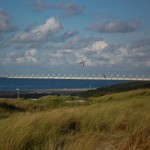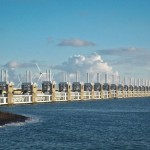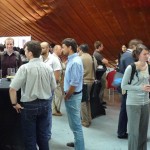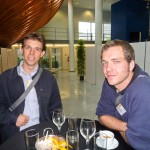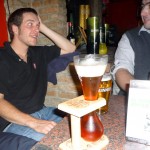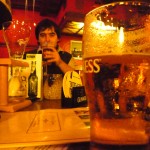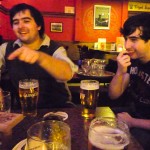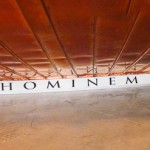Archive for 2010
Identi.ca Weekly Updates for 2010-10-06
- October 15th: Blog Action Day 2010 – #Water http://blogactionday.change.org/ #
- nice pictures: CIWM #environmental #photographers of the year: winners announced: http://ke-we.net/4p7 #
Die Zukunft des Wassers
In his book “Die Zukunft des Wassers: Eine Reise um unsere Welt”, Erik Orsenna presents the current state of the water related issues around the world by a series of short stories which are focused on a certain area of the world. Each of these stories, are compact and independently readable from the other stories, however they are nicely linked.
The book is very well translated, the original is French, which is one factor that leads to its great readability. Even though, I spotted one mistake at the end which is sort of sad for this book with its topic: “viaduct” was used instead of “aqueduct”. The other factor that enhances the book’s readability and authenticity is the knowledge about water-issues that Orsenna gained while travelling the world for two years and researching water problems. This knowledge is laid out in plain language, and the short stories are well understandable for everybody, no knowledge in water related topics is required. Some water-projects presented were new to me, for example the work that is underway in Singapore.

Erik Orsenna: Die Zukunft des Wassers
Later in the book, Orsenna touches on issues of water pricing, the discussion of water as a public or a private good, virtual water footprint at the end. The book closes with pointing out the importance of the agricultural sector — agriculture is the world’s biggest water user and polluter. Hence Orsenna proposes to start changing the behaviour of water use in this sector.
Geology-Moments, Math Education, Extreme Events
Important Geologic Experiences
Outside the Interzone publishes a series of blogposts where people are asked to contribute which are called “Accretionary Wedge” (a mass of sedimentary material scraped off a region of oceanic crust during subduction and piled up at the edge of the overriding plate). The 27th issue is on “Important Geological Experiences“. Most of them are hard-core geology-related.
There are two less core-geology posts:
- Cian Dawson (with his fairly new blog “Point Source“) wrote about his experiences with electrical resistivity surveys and about the associated “black box” inverse models. He comes up with the conclusion that “we must take the time to fully understand the tools we use, whether we’re talking about a compass in the field or software in the office“. Nicely put!
- Anne Jefferson at “Highly Allochthonous” writes about her affinity with floods (or vice vera) and shows some pictures of extensive flooding at an unlikely location: Alice Springs, Australia
Math (and other) Education
Jon McLoone at the Wolfram Blog wrote on math education. Using the example of calculating the range of a gun, he makes the point that our math education is missing reality. Typical problems in math education are over-simplified, and when computers are used together with those simple examples, there is nothing left to think about.
I am not sure if I agree. On the one hand I do, because I hated the style we were taught analysis in high school, which is cookbook style. We weren’t even told, what the first derivative of a function means, we simply had to calculate its coordinates. On the other hand, I think it’s simply important that you can calculate derivatives.
The example he comes up in a very structured step-by-step approach is indeed very much more realistic, and I can see how it can improve understanding of the subject. And I would argue if somebody who is learning analysis can code the problem like Jon in his example, even the “dumb model” he has gained quite decent understanding.
Which leaves the question of what computers, what programming language should be taught? Does it matter at all? Just any? At which point in the education? In my teaching experience I am faced with 3rd year engineers who have never used Excel.
Extremes Seem to Have Become the Norm
Andrew Revkin writes about “Weird Weather in a Warming World“. There have been many “extreme” floods this summer, in the US, in Pakistan, and currently in Germany (amongst many others, I’m sure). These observations can quickly lead to the conclusion that the return period for a given intensity shrinks and shrinks, possibly due to climate change. However, Andrew points out, there is no evidence for this conclusion (yet).
However, he points out (in a blog post at dotearth) that “the odds of extreme and prolonged heat or heavy rains will rise with an unabated buildup of warming emissions.“
Identi.ca Weekly Updates for 2010-09-22
- at #IAHR #Valencia: http://iahr2010.upv.es #Groundwater #meeting #
Identi.ca Weekly Updates for 2010-09-22
- at #IAHR #Valencia: http://iahr2010.upv.es #Groundwater #meeting #
GeoEnv Ghent
From Monday to Wednesday, I was at GeoEnv in Ghent, Belgium. It was a great conference, and most importantly, people seem to start to realize that spatial copulas have advantages compared to traditional geostistical tools. I hope to post more content here, for now, enjoy some pictures:
Identi.ca Weekly Updates for 2010-09-15
- NYTimes: 3-D Printing Spurs a Manufacturing Revolution http://nyti.ms/8XB6fZ (via @BrianShiro) @micha_N #
Identi.ca Weekly Updates for 2010-09-08
- How Should We #Think About #Extreme #Weather Events?by Pew Center's Jay Gulledge http://bit.ly/caK6mM #esci sem (via @highlyanne) #
- @clasticdetritus, how did you find out how many submissions there are to the session you submitted an abstract to at #agu10 in reply to clasticdetritus #
- @Allochthonous geoblog/tweeter meet-up! at #AGU10 sounds awesome. Can't believe it's almost a year! #
- @westcenter your Rock Party at #AGU10 to celebrate serpentine sounds like a plan! (via @theAGU) #
Math, Maxwell’s Equations, Nabla, and Statistics
Today I read works from Steven Strogatz and Daniel Fleisch. Both were on math, on fairly different topics, and hence lead to this somewhat mixed title.
A while ago I linked to Steven Strogatz’s series on mathematics in the New York times. The series seems to have come to an end, with some interesting new stories, on integration, differentiation. and probability among others. Here’s an interesting quote on his essay on change:
There’s a more general principle at work here — things always change slowest at the top or the bottom. It’s especially noticeable here in Ithaca. During the darkest depths of winter, the days are not just unmercifully short; they barely improve from one to the next. Whereas now that spring is popping, the days are lengthening rapidly. All of this makes sense. Change is most sluggish at the extremes precisely because the derivative is zero there. Things stand still, momentarily.
Recently, I have read somewhere about Daniel Fleisch and his book “A Student’s Guide to Maxwell’s Equations“. At first glance, I have nothing to do with Maxwell’s equations. However, I thought that a field is a field, be it electric potential or water pressure. First, this is the first time I read a book that was that clearly structured. Essentially each of the four laws (Gauss laws for electric and magnetic fields, Faraday’s law, and Ampere-Maxwell law) cover one chapter, and the final chapter is about how Maxwell “developed his comprehensive theory of electromagnetism” by considering these four equations in combination. This seems not like anything special. However, the structure is in each chapter essentially identical: first the terms of the mathematical equation are briefly explained, then there’s a section on what this is about, the physical meaning, and then there are sub-chapters on every term, sometimes “only” on the sign (in the case of Lenz’s law). I think the critical factor that makes this approach superior to other approaches is how Fleisch links between the equations. Where are similarities in equations? Are they because of similar physical processes? And how are physical processes covered mathematically?
Why do I think all this is relevant? In most disciplines I have worked in, this way of thinking is important: How is a process covered in mathematics. Even more, the way of thinking is essentially the same — it doesn’t matter what kind of field you’re looking at. There is even a quote attributed to Maxwell in the preface: “… analogies are useful not because the quantities are alike but because of the corresponding relationships between quantities“. And by Fleisch: “… although nothing is actually flowing in a static electric field, you’re likely to find the analogy between a faucet (a source of fluid flow) very helpful in understanding the nature of the electrostatic field“. And I think the reverse holds true too. Additionally, Fleisch does a really excellent job in explaining details of the Nabla operator, divergence, curl, and gradient.
Here is one example taken from Fleisch’s book, which is directly relevant to statistics:
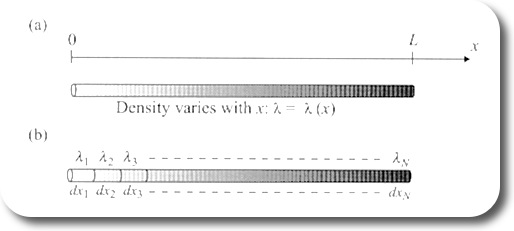
Figure 1: Line integral for a scalar function
Figure 1a (Figure 3.2 in Fleisch’s book) shows a wire with variable density. Here is how Fleisch describes what has to be done to determine the mass of the wire. In other words, what has to be done to find the distribution function from its density function.
To determine the total mass of the wire, imagine dividing the wire into a serios of short segments over each of which the linear density is approximately constant, as shown in Figure 1b. The mass of each segment is the product of the linear density of that segment times the segment length dx, and the mass of the entire wire is the sum of the segment masses
Identi.ca Weekly Updates for 2010-09-01
- python -c "import urllib; print urllib.urlopen('http://ke-we.net/2o6').read().split('<p>')[-1].split('</p>')[0]" | xargs -i hg commit -m {} #
- @scottstevenson This is the hilarious! in reply to scottstevenson #
